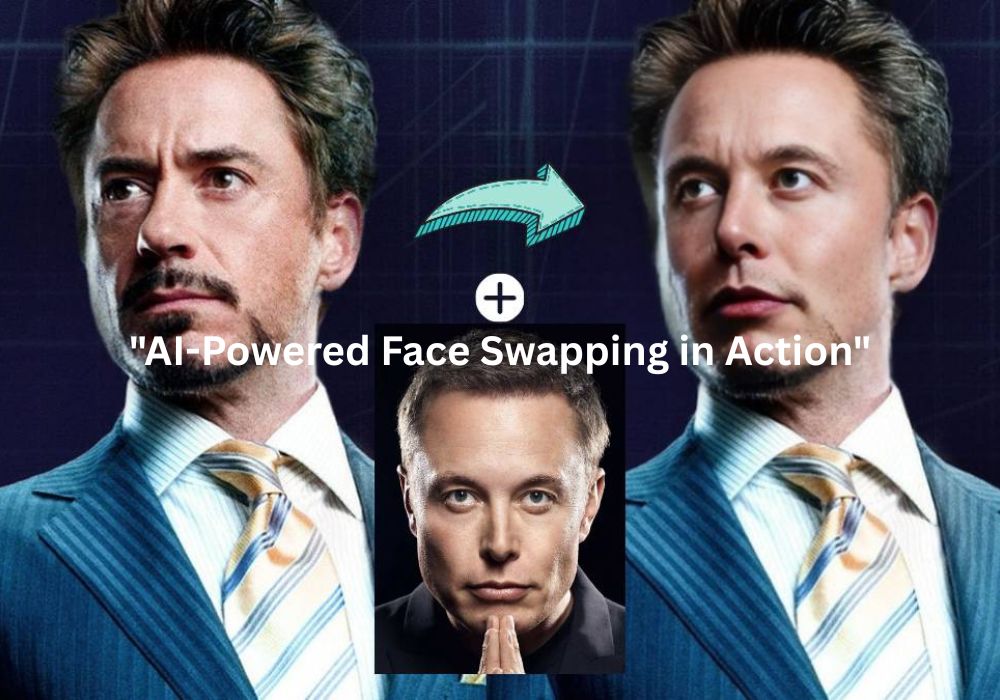Technology
Face Swap Magic: How Face Swapping Video Apps Are Transforming Digital Content

Face swapping video apps have become the new playground for creators, influencers, and everyday users looking to add a dose of fun, creativity, or even shock value to their content. From viral TikToks to hilarious Instagram reels, these apps are taking over — but what exactly makes them so popular, and which features should you be looking out for?
Let’s dive into the fascinating world of face swapping video apps, explore how they work, and understand why they’re more than just a fun trend.
What Is a Face Swapping Video App?
A face swapping video app is a tool powered by artificial intelligence (AI) and deep learning that allows users to swap one face with another in a video. Whether you’re putting your face on a celebrity’s body or creating a multi-character swap in a group video, these apps make it incredibly simple — often in just a few taps.
These apps have gained momentum not only in entertainment but also in marketing, filmmaking, gaming, and even education. With the rise of short-form video platforms, the demand for interactive, humorous, or surreal content is at an all-time high — and face swap tools are delivering just that.
How Face Swapping Technology Works
Behind the scenes, most face swapping video apps rely on deepfake technology — a type of AI that uses deep learning to map facial features and expressions from one person to another. Here’s a breakdown of how it generally works:
-
Face Detection: The app identifies and isolates facial features from the video.
-
Face Mapping: Using AI, it creates a digital mesh or map of the face to capture expressions and angles.
-
Face Overlay: Your chosen face (or someone else’s) is blended seamlessly into the video with natural motion.
-
Rendering: The app processes and outputs a realistic-looking video with the swapped face(s).
All of this happens in seconds with modern apps — no technical knowledge required.
Why Are Face Swapping Video Apps So Popular?
Let’s be honest — who hasn’t wanted to see themselves in a movie scene, a music video, or even a meme? Here are a few reasons why these apps are exploding in popularity:
1. Entertainment Value
The ability to swap faces with celebrities, friends, or fictional characters adds a hilarious twist to everyday videos.
2. Creative Storytelling
Content creators can use these tools to reimagine scenes, act out multiple roles, or create parodies — all from a single device.
3. Social Media Ready
Face swap videos are inherently shareable and often go viral, making them perfect for platforms like TikTok, YouTube Shorts, and Instagram Reels.
4. Accessibility
Most apps are free or low-cost, and require zero editing skills. Anyone with a smartphone can join the fun.
Key Features to Look For in a Face Swapping App
Not all apps are created equal. If you’re considering jumping into the world of face swapping, look for these standout features:
Multi-Face Swapping
Some top-tier apps allow you to swap multiple faces in a single video — perfect for group shots or cinematic scenes.
High-Quality Output
Pixelated or glitchy swaps kill the fun. Look for apps that offer HD rendering and smooth transitions.
Video Support (Not Just Photos)
Many basic apps only support images. Make sure yours can handle dynamic video content for more impact.
Customization Options
Whether it’s adjusting expressions, aligning facial features, or changing skin tone to match lighting — customization elevates realism.
Privacy & Security
Reputable apps will have clear policies about how they use your data and will not store your uploads without consent.
Top Face Swapping Video Apps You Should Try in 2025
Here’s a quick look at some of the most popular and trusted apps leading the face swap trend:
-
Reface App – Great for quick celebrity swaps and meme-style content.
-
FaceMagic – Allows multi-face swapping and offers AI avatars.
-
Zao – A Chinese app known for hyper-realistic deepfake effects.
-
DeepSwap – Web-based tool ideal for high-quality, realistic face swaps in longer videos.
-
Snapchat – Yes, the OG! Its face swap filter is still going strong with regular updates.
Always check reviews and data privacy policies before uploading personal content.
Is It Ethical to Use Face Swapping Apps?
That’s a valid question — and an important one. When used responsibly for fun or artistic expression, face swapping apps can be harmless. However, deepfake technology has raised concerns about misinformation, impersonation, and digital consent.
Here are some ethical guidelines to follow:
-
Always get consent if you’re using someone else’s face.
-
Avoid misleading content that could cause confusion or harm.
-
Be transparent if you’re sharing altered videos in public.
How Face Swapping Is Shaping the Future of Digital Media
Beyond fun videos, face swapping technology is influencing:
-
Film & TV Production: Actors can now appear in scenes without physically being there.
-
Gaming: Personalized avatars with real faces are becoming a thing.
-
Virtual Reality (VR): More immersive experiences with identity customization.
-
Education: Creative storytelling and historical recreations using face swaps can make learning more interactive.
What started as a gimmick is slowly turning into a powerful creative tool across industries.
Final Thoughts
Face swapping video apps are more than just a digital party trick. They’ve evolved into powerful creative tools, unlocking endless possibilities for personal expression, humor, and storytelling. As technology improves, expect even more realistic and accessible features — but remember to use them ethically and responsibly.
Ready to swap faces and create something unforgettable? Try out a face swapping video app and step into someone else’s shoes — literally!
FAQs About Face Swapping Video Apps
Q1: Is face swapping safe?
Yes, if you’re using reputable apps that don’t store or misuse your data. Always check the app’s privacy policy.
Q2: Can I use face swapping apps for commercial purposes?
Only if you have the rights to use the faces involved. Using celebrity or public figure likenesses for profit can land you in legal trouble.
Q3: Do I need a powerful phone to use these apps?
Most modern apps are optimized for average smartphones, but high-resolution rendering may require better processing power.
Q4: Can I swap faces in videos with multiple people?
Absolutely. Some advanced apps like FaceMagic and DeepSwap allow multi-face swaps in one go.
Q5: Are these apps free?
Most offer free versions with basic features. Premium subscriptions unlock HD exports, longer videos, and ad-free experiences.
READ ALSO:
Technology
Elevating Luxury Branding Through 3D Rendering

In the high-stakes world of luxury branding, first impressions are everything. Visual storytelling, elegance, and detail define success. Enter 3D rendering — the silent powerhouse that’s transforming how premium brands present themselves in a digital-first world. From jewelry to fashion to high-end real estate, 3D rendering also digital rendering is no longer optional — it’s essential.
Let’s explore how 3D rendering enhances branding for luxury products, and why it’s the competitive edge your brand needs in 2025.
What Is 3D Rendering?
3D rendering is the process of turning 3D models into photorealistic images or animations. Think of it as digital photography without a camera — perfect lighting, flawless textures, and endless creative freedom.
For luxury brands, this means:
-
Flawless product visualization
-
Immersive storytelling
-
Customization at scale
Why 3D Rendering Matters for Luxury Brands
Luxury is about perception, and perception is deeply visual. Digital rendering helps elevate that perception through:
1. Hyperrealistic Product Showcases
Display every curve, shimmer, or texture with stunning precision. Perfect for:
-
High-end watches
-
Designer handbags
-
Premium cosmetics
You can zoom in on intricate details, show materials in various lights, and highlight craftsmanship — all without a photoshoot.
2. Cost-Efficient Content Creation
Forget expensive reshoots. With Digital rendering, you can:
-
Recreate environments (beaches, studios, runways)
-
Change colors or styles instantly
-
Produce assets for multiple campaigns from one base model
It’s efficient and environmentally friendly.
3. Seamless Omnichannel Branding
Use the same 3D model across:
-
Social media
-
E-commerce
-
Print ads
-
AR/VR experiences
Your product maintains a consistent appearance across all platforms — building trust and reinforcing a sense of luxury.
4. Personalized Customer Experiences
Want to show a luxury sofa in a client’s exact living room color scheme? Digital rendering enables real-time customization, giving clients the feeling of a tailored, exclusive experience.
Luxury Industries Embracing 3D Rendering
High-End Watches
Showcase mechanisms, textures, and materials in a way that traditional photography can’t match.
Fashion & Footwear
Showcase clothing on animated virtual models with realistic fabric movement — ideal for online lookbooks and metaverse previews.
Real Estate & Interior Design
Market luxury homes before they’re built. Offer virtual tours and immersive walkthroughs with architectural precision.
Jewelry
Show off diamonds, metals, and intricate designs in ultra-high resolution — zoom in, rotate, or change backgrounds with ease.
How 3D Rendering Enhances Digital-First Branding
Luxury consumers now browse, compare, and purchase online more than ever. 3D rendering allows your brand to:
-
Tell a captivating visual story
-
Showcase innovation and craftsmanship
-
Deliver immersive, high-end online experiences
In short, you’re not just selling a product — you’re selling a lifestyle.
The Business Impact of Digital Rendering
-
Increase conversions with more engaging visuals
-
Boost brand prestige through cutting-edge presentation
-
Reduce time-to-market for new product visuals
-
Improve online shopping experiences with 360° views and interactivity
Luxury is in the details — and 3D rendering helps you control every pixel.
Tools Powering Luxury 3D Branding
-
Blender – Open-source and powerful for product modeling
-
Cinema 4D – Known for motion graphics and high-end visuals
-
KeyShot – Popular for photorealistic product renderings
-
Unreal Engine – Ideal for interactive and real-time experiences
-
Adobe Substance 3D – Exceptional for material and texture creation
FAQs:
Q1: Is 3D rendering better than traditional photography for luxury products?
In many cases, yes. It allows more control, flexibility, and creative freedom while maintaining (or exceeding) realism.
Q2: Can small luxury brands afford 3D rendering?
Absolutely. With open-source tools like Blender and freelance marketplaces, even boutique brands can access high-quality renders affordably.
Q3: Does 3D rendering work for social media marketing?
Yes! Instagram carousels, TikTok animations, and even AR filters can all be powered by 3D assets.
Q4: Can customers interact with 3D-rendered products?
Definitely. Many e-commerce platforms now support 360-degree views, zoomable renderings, and interactive configurators.
Final Word
In luxury branding, visuals aren’t just accessories — they’re the entire outfit. 3D rendering gives you the power to craft flawless, flexible, and forward-thinking brand visuals that captivate today’s discerning consumers. If you’re aiming to position your brand as elite, innovative, and unforgettable — Digital rendering is the tool to get you there.
READ ALSO:
More
Unlocking Careers with AI: Find The Best Ai Job Search Tools in 2025
Technology
Web Testing Tools: Your Ultimate Guide to Quality Website Assurance

In the fast-paced digital world, websites are expected to be responsive, secure, and user-friendly — all at once. Whether you’re launching a simple blog or managing a complex e-commerce platform, web testing tools are essential for ensuring your site performs flawlessly.
This guide will walk you through what web testing tools are, why they matter, and the best tools available today.
What Are Web Testing Tools?
Web testing tools are software applications or platforms designed to evaluate various aspects of a website. These tools enable developers, testers, and QA teams to verify that a website or web application:
-
Functions correctly (functional testing)
-
Loads quickly (performance testing)
-
Looks good across devices (responsive testing)
-
Stays secure (security testing)
From manual testing suites to automated testing frameworks, these tools are crucial in catching bugs, improving UX, and boosting SEO rankings.
Why Use Web Testing Tools?
1. Ensure Functionality
Web testing tools validate whether buttons, forms, navigation menus, and interactive elements work as expected.
2. Improve User Experience
By checking responsiveness and accessibility, they help deliver seamless experiences across devices and browsers.
3. Enhance Security
Many tools offer penetration testing or vulnerability scanning to identify and fix weak points.
4. Boost Performance
Tools can simulate traffic and measure load times, helping you optimize site speed — a vital factor in SEO and conversions.
Categories of Web Testing Tools
| Testing Category | Purpose | Tools Examples |
|---|---|---|
| Functional Testing | Test core features like forms, logins, and buttons | Selenium, TestComplete |
| Performance Testing | Assess speed, stress, and scalability | JMeter, LoadNinja |
| Responsive Testing | Ensure proper display on different devices | BrowserStack, LambdaTest |
| Security Testing | Identify vulnerabilities | OWASP ZAP, Acunetix |
| Usability Testing | Gather real-user feedback | Crazy Egg, Hotjar |
| Regression Testing | Ensure new updates don’t break existing features | TestNG, QTP |
Top Web Testing Tools in 2025
1. Selenium
A highly popular open-source solution for automating browser-based testing.
Key Features:
-
Supports multiple languages: Java, Python, C#
-
Cross-browser compatibility
-
Integrates with CI/CD tools like Jenkins
Best For: Automation engineers and testers working on dynamic web apps
2. Cypress
Highlights:
-
Operates directly in the browser
-
Great for testing modern front-end frameworks like React or Angular
-
Automatic waiting and real-time reloads
Ideal for: Agile teams and contemporary web applications.
3. TestComplete
A commercial testing tool with support for both scripted and scriptless testing.
Key Benefits:
-
AI-based object recognition
-
Integrates with Jenkins, Jira, Git
-
Reusable test scripts across desktop, mobile, and web
4. BrowserStack
Advantages:
-
No setup needed – test instantly in the cloud
-
Access to 3,000+ real browsers and devices
-
Supports Selenium and Cypress
Best For: Manual and automated cross-browser testing
5. OWASP ZAP (Zed Attack Proxy)
An open-source security testing tool developed and maintained by the Open Web Application Security Project (OWASP).
Key Features:
-
Automatic vulnerability scanning
-
Passive and active scanning options
-
Works well with CI/CD pipelines
Best For: Security-conscious developers and pentesters
Choosing the Right Web Testing Tool: What to Consider
When selecting a web testing tool, evaluate the following:
-
Project Needs: Are you focusing on automation, security, or user experience testing?
-
Team Skills: Are your team members developers, QA testers, or non-tech users?
-
Budget Constraints: Open-source tools vs. premium platforms
-
Integration Capabilities: Does it support your tech stack (CI/CD, version control)?
-
Scalability: Can it handle the size and traffic of your growing web app?
How Web Testing Tools Fit into Agile and DevOps
They help teams:
-
Run tests in every development sprint
-
Integrate with CI/CD pipelines
-
Deliver faster with fewer bugs
Automation + Web Testing = Continuous Quality
Benefits of Using Web Testing Tools
-
Faster issue detection
-
Increased efficiency through automation
-
Improved customer satisfaction and trust
-
Improved SEO rankings, driven by enhanced performance and accessibility testing.
-
Reduced downtime and deployment risk
Challenges in Web Testing
-
Browser compatibility: Ensuring consistent experiences across browsers
-
Mobile responsiveness: Testing devices with different OS, screen sizes, and resolutions
-
Dynamic content: Ajax and JavaScript-heavy sites can be tricky to test
Solution: Use tools like BrowserStack, Cypress, and Selenium Grid for robust testing coverage.
FAQs
Are web testing tools only for developers?
No — while many are developer-friendly, tools like Test Complete or Browser Stack cater to non-tech users too.
Can I test my site for free?
Absolutely—open-source tools such as Selenium, Cypress, and OWASP ZAP are available at no cost.
Which tool is best for mobile website testing?
BrowserStack and LambdaTest are excellent for real-device testing.
Do web testing tools help with SEO?
Indirectly, yes. Tools that improve speed, fix bugs, and ensure accessibility positively impact your SEO rankings.
Is automation better than manual testing?
Automation excels at handling repetitive tasks, whereas manual testing is ideal for assessing usability and conducting exploratory testing.
Conclusion
Web testing tools are no longer optional — they’re a necessity for any business serious about delivering high-quality, secure, and responsive websites. Whether you’re a solo developer or part of an enterprise DevOps team, choosing the right set of tools can significantly reduce errors, improve user satisfaction, and streamline your deployment process.
Invest in smart web testing today — and your users (and Google rankings) will thank you tomorrow.
READ ALSO:
Msafely: The Ultimate Solution for Discreet Phone Monitoring and Safety
-

 More6 months ago
More6 months agoThe Rise of Lillienu: Transforming Technology and Creativity
-

 Fashion6 months ago
Fashion6 months agoUnveiling the Secrets of Ceylan Eye Cream Reviews
-

 More7 months ago
More7 months agoThe Rise of Artofzio: Transforming Creativity in the Digital Era
-

 More7 months ago
More7 months agoSwindle Trilogy Website: A Must-Visit Hub for Book Lovers
-

 More6 months ago
More6 months agoInfluencersginewuld: Revolutionizing the Influencer Marketing Landscape
-

 More6 months ago
More6 months agoCeylan Eye Cream Reviews: Is It Worth the Hype?
-

 Business6 months ago
Business6 months agoIvermectin: The Medication That Changed Global Health
-

 Lifestyle6 months ago
Lifestyle6 months agoAdrianna Apostolec: 5 Inspiring Career Highlights & Untold Stories

